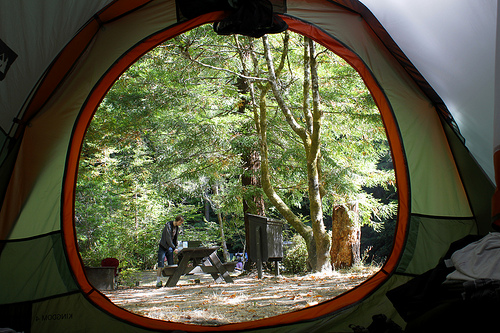How To Camp In America’s National Parks

If you’ve been camping before then you’ll be well-aware of the perils and pitfalls that come from a lack of preparation and undertaking life in the outdoors whilst in America is absolutely no different.
Of course, there are plenty of all singing all dancing camp sites, especially on the east coast, however, if you fancy really getting back to nature then the national parks of the west are exactly what you’re looking for.
Yosemite, Yellowstone and Sequoia High Sierra in California are all exceptional camping grounds and if you’re looking to ensure you have a safe and successful trip then read on for tips and advice.

If you’re travelling in the summer then you may think that all you’ll need are some t-shirts and short trousers however, even after sweltering days the nights can get extremely chilly and if you’re in the desert you’ll need something warm to wear. Long sleeves, long trousers and hats are the order of the day and from fighting off mosquitoes to keeping safe in the sun, make sure you pack for all eventualities.
Continuing on the packing theme it’s essential to bring a day pack to take with you on expeditions such as hiking or even picnics. Ensure you’re comfortable with carrying your lighter load and don’t forget to pack warm clothes, water and snacks in the unlikely event of getting lost or coming back to camp later than anticipated.
Whenever you’re camping there will be a certain amount of rubbish that accumulates through packaging and discarded food stuffs. It’s essential to keep a clean camp as you never know what kind of animals your refuse will attract and the likelihood of ants, wild dogs and even bears is much more considerable the further into the wilderness you venture.
If you are contemplating really getting away from it then don’t forget to load your car or van with all the supplies that you’re going to need whilst away from home. American national parks are perfect for camping however, don’t expect them to have stores laden with equipment especially if you’re exploring off the beaten trail.
Being aware of where you are on your USA holidays and how you can get back to base camp is essential for your safety and to avoid getting lost in the wild. Make sure you have a map, compass and, if possible, a GPS tracking system to give you the best chances of orientation. Don’t expect to find a communication signal so far from home so get used to using a map and compass to avoid a worse case scenario.
Following well-sign-posted trails is the best means of staying safe and avoiding getting lost. America’s national parks are criss-crossed with well-trodden paths and excellently maintained tracks that will take you to some awesome areas of natural beauty. Straying too far from the path may seem like a good idea however, you may be damaging the landscapes and also putting yourself in danger – stick to the path!
It’s an excellent idea to seek out and visit the local information centres that are run by knowledgeable wardens and rangers. These places are ideal for getting to know tips and advice about the area from local people who have been in a camping environment all of their lives. From maps and guide books to stickers and badges, there’s no reason not to pop in and say hello.
It may seem like the adventurous thing to do to stop off by the side of the road or in a non-designated camping area but this can often lead to campers getting into difficulties, especially at night. Roaming bears, bad people and dangerous landscapes are 3 good reasons to stick to designated camping grounds and even though you’re staying near other campers the chances are that you’ll only heighten your outdoor experience.
When camping you are literally becoming one with nature and although you’re sleeping under canvas or within the confines of a van, you will still be encountering plenty more insects, birds and animals than you would do at home. Taking a nature guide book is an excellent means of ticking off and learning as you go and before long you’ll be able to recognise plants and animal tracks like a pro.
All camping expeditions need to have a fully-stocked first-aid kit no matter how long the length of stay or whatever the location. There are untold chances to have an accident and even the most innocuous cut or bruise may turn nasty if not immediately treated. You may find yourself staying far away from hospitals and doctors and the ability to perform first-aid or cover a wound could make all the difference before the services are finally alerted to your plight.
